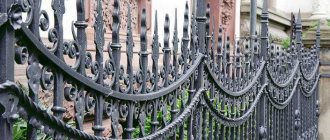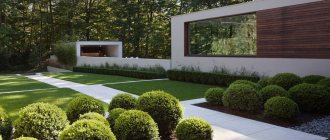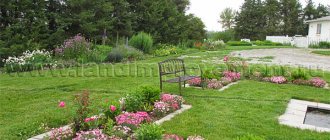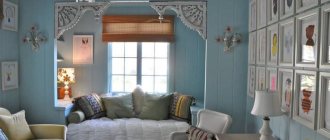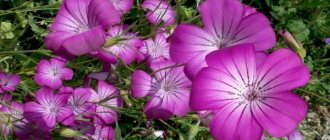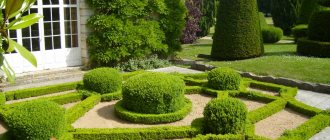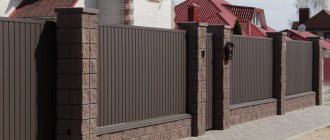In order to make your territory beautiful and unique, it is not at all necessary to invite landscape design specialists. You can organize everything yourself with the help of your imagination and some practical tips. There are many styles that are widely used to improve the local area. The most common of them are classic, English, rustic (country), high-tech and alpine. Thanks to its expressiveness, the Alpine style has become widespread where the area is small and the area has uneven terrain. This allows you to create exceptionally picturesque compositions.
Style Features
The Alpine style seems to copy the amazingly beautiful places of Alpine Switzerland and France. Since this is a mountainous area, many compositions are based on elevation changes. Creating an alpine style on a flat area will require various earthworks, since hills, slopes and embankments are integral elements of this style. You can create an alpine corner on a plot of 4-5 acres in size, but it is advisable to exclude shaded areas. In this case, the bright sun is one of the architects and designers of the style.
Alpine style is also called
chalet style. Its peculiarity lies in the naturalness of the materials used, creating naturalness in the courtyard.
In which regions is it relevant?
More precisely, we cannot talk about whether it is relevant or not to use compositions in the Alpine style in a given region. It is important - you will get a beautiful result or the work will be in vain. You should not use the alpine style if the site is completely flat and located in a lowland. No matter how beautifully the compositions are executed, the expected effect will not be achieved. With regard to the climatic characteristics of the region, restrictions may be imposed on the use of certain plant species.
Ideally, the Alpine style implies not only elements of landscape design, but also permanent residential buildings made in the chalet style.
Use of reservoirs
To create a special flavor, it is recommended to use different types of reservoirs on the site. If you are creating an alpine-style garden, then the best option would be:
- Flowing streams that carry life-giving moisture.
- Ponds located at the foot of the hill.
Thanks to such reservoirs, it is possible to make the artificial landscape closely resemble the natural one, combining elements of a rock garden and rocky embankments.
Alpine style in landscape design is the best option to decorate an unpromising area. Thanks to simple compositions, you can create a piece of paradise next to your home, which is not only durable, but also easy to maintain.
Was this article helpful?
Thank you for your opinion!
Write in the comments what questions you have not received an answer to, we will definitely respond!
You can recommend this article to your friends!
Already helped 3 times
Essential elements
Alpine style is a small piece of mountainous Switzerland, transferred to Russian realities. Only elements of the natural and natural landscape are used here, so it is advisable to exclude all kinds of artificial materials. In the alpine style, unlike high-tech, there is a complete absence of plastic, chromed metal and mirror glass. The main design material in the alpine style is stone, which can be complemented by untreated wood.
Gazebos for summer cottages should also be made of wood, barbecues and barbecues made of stone.
River or sea pebbles, as well as coarse sand, are often used. Water is also an important part of the Alpine style. You can use ceramics or baked clay products. The main elements of this direction are the following small architectural forms and compositions:
- paths;
- awnings;
- gazebos;
- small ponds;
- streams;
- waterfalls;
- alpine slides.
The mountain style completely excludes straight paths and any corners, since there is no such thing in the natural landscape. Winding paths of small width, imitating mountain paths, can be paved with tiles and framed with untreated pieces of natural stone. Since purchasing granite or basalt in central Russia can be associated with some difficulties, you can use artificial stone for design, which is indistinguishable from natural stone in appearance. It is sold in rough pieces of various sizes and is well suited for alpine compositions.
Unlike the mountain style of an alpine hill, unpretentious greenery grows on the flat area of Dutch houses. Dutch gardens are bright and cheerful thanks to the use of colorful flowers.
Pebble or rocky paths, unframed by a border, best characterize the alpine or chalet style.
Canopies or pergolas are made of natural wood and framed with climbing plants. Smooth rectangular designs should be avoided, since the softness of the lines fits well with the natural style. As decorative elements, you can use picturesque driftwood covered with moss and abstract sculptural compositions. The main thing is that there are not too many of them, so that attention is not distracted from the perception of the picture as a whole. If the size of the plot allows, then one or two gazebos can be placed on it, preferably at different levels and differing in architecture.
Small ponds with a sandy or rocky bottom really enliven the overall picture. They can be connected by streams, with rocky riverbeds, which, like the paths, have a winding shape. If the entire water extravaganza is located at different levels, then small waterfalls and wooden mill wheels will not be out of place in the composition. Small bridges over streams significantly enliven the composition.
Find out how to make an artificial pond on your site in this article.
Small ponds with sandy bottom
One of the important elements of the style is the alpine slide. It should be located on a level area and so that it can be seen from anywhere in the garden. Such a hill can be the dominant feature of the entire garden composition, so there should be no tall buildings or large trees nearby, since the hill should always be illuminated by the sun.
There are certain rules according to which an alpine slide should be created. If they are not followed, instead of a picturesque composition you will end up with a sloppy pile of stones.
Plants
It is impossible to imagine any garden design project that would not include various plants. In the alpine style, plant cover plays a big role. Naturally, this style involves the use of certain plants. It is very good to use the following coniferous trees in the alpine style:
- thuja;
- juniper pyramidal;
- creeping juniper;
- dwarf pine.
You can use other species of coniferous trees, but preference should be given to dwarf mountain varieties, which will fit perfectly into any alpine composition. Thuja and pyramidal juniper are used in vertical gardening of the site. In addition to trees, shrubs are used in garden compositions:
- chokeberry;
- barberry;
- lilac;
- currant;
- gooseberry.
The red bush is barberry.
The following plants will look good in decorative flower beds:
- asters;
- lilies;
- poppies;
- saxifrage;
- cat's paw
Find out how to make a pool near your house with your own hands in this material.
Blooming saxifrage
Alpine compositions use irregularly shaped flower beds, for the design of which ferns and moss are successfully used. Interesting solutions could be flower beds-strips forming a spiral. In general, with alpine design, classic flower beds where only flowers grow are practically not used. Small piles of stones look great, among which carnations or pansies stand out as bright spots. Dry plants and ears of cereals can be used as design elements.
There are varieties of green spaces that are often called alpine plants. Usually these are low plants that form a dense layer that seems to spread and cover the voids between the individual stones.
Alpine palette
The beautiful alpine palette lies in the contrast between greenery and rocky shades. Buildings made in gray and brown colors look quite unusual and aesthetically pleasing.
You can also add natural stone and wood that has aged a little. Flowering plants and shrubs will complement the bright landscape.
Important! Place the house and outbuildings at the highest point in the garden. This way all design compositions will be better visible.
Layout features
The main thing in the alpine style is the closeness to the natural landscape. Therefore, everything used in the design of this style should not introduce anything that is not found in nature. In nature, paths do not intersect at right angles, which means they should not exist on the site. The stream also flows along a winding channel, flowing into small ponds that can form entire cascades. Tall structures should be avoided as they may block areas of the landscape.
Stone steps as a design element for a summer cottage
The alpine garden, located on several terraces, looks very picturesque. This relief will allow you to create beautiful compositions with streams and rocky waterfalls. Between the ledges you can lay stairs made of stone slabs, which may differ in width and design. When planning a site in an alpine style, you should abandon solid partitions. The boundaries of individual zones are purely symbolic and can be made from pieces of stone.
It is desirable that all zones are clearly visible, so the house or utility buildings should be located at the highest point of the site and not overlap the design compositions.
Alpine-style houses - layout options
Today, the chalet combines the latest construction technologies and the architectural traditions of “shepherd’s houses”. A modern alpine house can be built from brick or aerated concrete.
The facade is often plastered and painted in neutral shades. Wooden frames on the windows replaced double-glazed windows. The location for building a chalet house is chosen depending on the cardinal directions. This is done to ensure that daylight penetrates into the room throughout the day.
The gable roof protects the walls and basement from precipitation. Arranging the interior space of a house involves organizing an attic space. Therefore, you need to carefully choose the type of roof that will ensure a comfortable stay in the attic. The basement of the house is made of brick, wild stone, and concrete. The layout of the chalet house includes an attic, a balcony, a veranda, and a garage. On the ground floor there is a hall, a living room, a kitchen, mainly combined with a dining room.
Ground floor plan
Attic floor plan
The second floor is designed for a bathroom and toilets, a billiard room, a bedroom, a dressing room, a nursery, a library, and a guest room. However, in addition to two-story chalets, one-story cottages are also designed in this style. In this case, all residential and utility rooms are located on the same level, which allows you to arrange the interior space with a unique design.
Color solutions
In color schemes, the Alpine style is based on contrasts. The main structural material of the style is stone, which has all shades of gray, brown or brown, as well as wood. Therefore, bright spots of color will add a unique flavor to any composition. The main thing here is to have a sense of proportion. Silver-green can be considered as the main color. This is the color of some varieties of ornamental grass and certain types of mosses. Stones and wood go well with this background.
In order to emphasize pastel colors with the help of contrast, bright compositions of flowers are used in alpine design. Preference is given to red, yellow and orange. Very good among warm reddish shades, cold and bright splashes of blue and violet. A photo of the flower garden design in front of the house can be found at the link.
Alpine-style pansies can just become that bright element of decor
Chalet landscape design
You can create a piece of the Alpine mountains on your site by carefully approaching this issue. Such a landscape does not tolerate whitewashed garden trees or the diversity of village flower beds. But compositions of alpine slides and an abundance of stone elements entwined with greenery are welcome.
The mountain style is recreated with the help of conifers, barberry, cotoneaster, various spireas and euonymus. Among the flowers, phlox subulate, aster, all types of sedum and saxifrage perfectly complement the landscape design. The main thing is to remember that a riot of colors in such a garden is inappropriate.
Accessories
The picturesqueness of the Alpine style is based on a combination of plants, stone and wood, which in itself is considered one of the most beautiful in nature. If you add water to this, then this solution can be called ideal. Once the basic shaping of the alpine section is completed, some scenic accessories can be added.
A large ceramic or clay vessel lying on its side and partially broken would look appropriate. It is filled with soil and bright plants are planted in it. Such small architectural forms as sculptures and vertical flower vases are not used, since this is alien to nature. You can install small abstract compositions, but not too flashy. They should be part of the style, and not fall out of it.
Alpine style is one of the most popular landscaping styles described here.
You can use old things that are no longer suitable for use as decorative elements. These could be broken clay pots, old wheels, baskets. They can be used as stands for flower pots and for climbing plants.
If it is not possible to organize streams and waterfalls on the site due to difficulties with water supply, you can make “dry streams” in the form of a bed lined with stones and pebbles. To make it clear that this is still a stream, a decorative bridge can be built across the bed. For evening lighting of the area, you should use small-sized LED lamps, which should be disguised among the stones so that they are not conspicuous. Individual pieces of stone or cobblestones scattered around the area will fit well into the alpine design.
Site design
Alpine landscape style is a picturesque set of different compositions. In the absence of traditional garden decorations, the following are appropriate:
- rock garden slides, with a central stone symbolizing the peak, and many smaller ones, beautifully alternating with ornamental plants reminiscent of their mountain counterparts;
- rock garden areas, also known as stone gardens, decorated with low-growing trees and shrubs;
- artificial streams and waterfalls that enliven the landscape;
- alpine lawns;
- stylized gazebos at “observation” points.
Tips for use
The alpine-style area does not require any serious maintenance, since there are no large lawns that need to be trimmed regularly. Of course, all plantings must be weeded and fertilizers must be used for better plant growth and development. In addition, before choosing plants, you need to make sure that they will not drown out each other.
When organizing streams, ponds and waterfalls, care should be taken to ensure that water does not soak into the soil. To do this, you can use waterproofing and a cushion of sand and gravel. You should make sure that the area is not overgrown, otherwise everything will look very sloppy.


